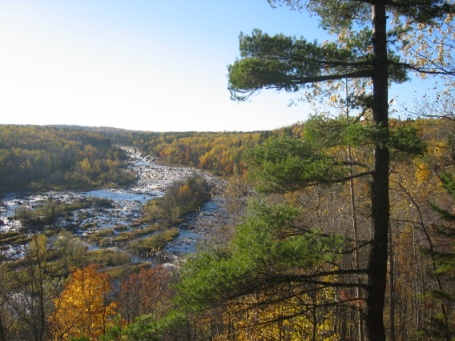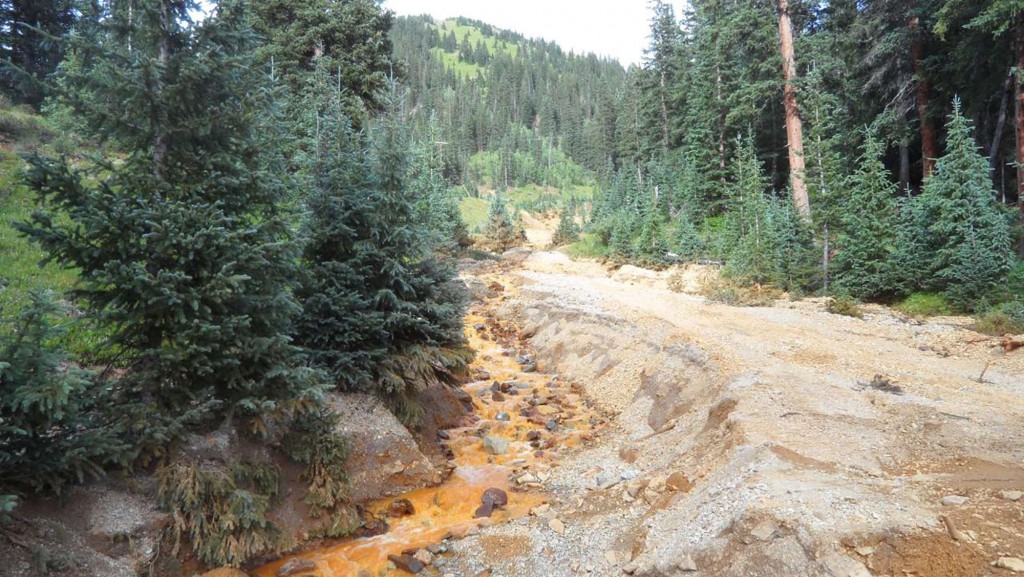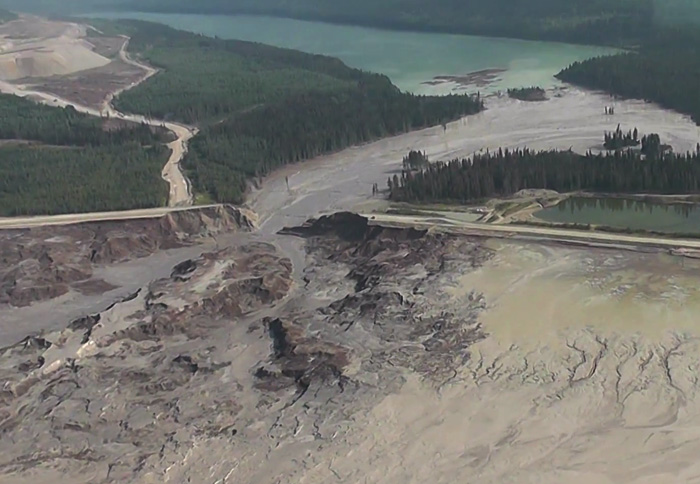 Lake Superior Headwaters, St. Louis River – Minnesota (Source: Lori Andresen)
Lake Superior Headwaters, St. Louis River – Minnesota (Source: Lori Andresen)
Downstream of the proposed PolyMet Mine
The PolyMet final Environmental Impact Statement (FEIS) was released to the public November 6th, 2015. How did PolyMet ever get this far? And why?
In 2010, the U.S. Environmental Protection Agency (EPA) rated PolyMet’s draft EIS as EU-3, Environmentally Unsatisfactory-Inadequate. Here are some quotes from the comments: “The EPA believes that the project will exceed water quality standards because of discharges during the life of the mining operation and on a long-term basis, including the post-closure period. These water quality impacts are largely related to water that contacts acid-generating waste rock … and to wastewater escaping the tailings basin through seeps and in ground water. …the analyses of the hydrogeological profiles at both the mine and processing site are inadequate to determine the full extent of impacts or to justify mitigation options. Consequently we believe that the DEIS likely underestimates water quality impacts and the project is likely to have additional unmitigated long-term discharges. EPA has identified information gaps relating to groundwater impacts, groundwater-surface water interaction, tailings basin stability and containment, and groundwater discharges to surface water. Furthermore, EPA does not agree with the compensation described for wetlands impacts… The DEIS did not provide information on financial assurance…”
The above are the same concerns brought forth by environmental groups as they made their way through hundreds of pages of the DEIS. These concerns included: “There is inadequate analysis. There is no substance to conclusions that claim there will be no water pollution. The scale of the mining operation is such that it will be impossible to contain water pollution. The tailings basin purchased from the former LTV Mining Company by PolyMet is already leaching sulfates and other pollutants into the watershed and is not designed to contain the amount or type of tailings that would be produced by PolyMet. The wetland loss at PolyMet’s NorthMet mine (nearly 1,000 acres direct/ 6,500 acres indirect) would be the single largest loss ever permitted by the St. Paul Army Corps of Engineers. The US Forest Service could deny an open pit mine operation on our public lands within Superior National Forest, rather than negotiating a land exchange that would privatize 6,500 acres of Superior National Forest lands, impacting wildlife and wildlife corridors. Acid Mine Drainage (AMD) and heavy metal pollution will be a problem for hundreds to thousands of years.”
The Devil Is in the Details
The PolyMet project should have been shelved in 2010. Instead, the Supplementary Draft EIS was released in December of 2013. In preliminary documents circulated prior to the SDEIS, environmental groups noticed that water treatment would be needed for at least 200 years at the mine site and at least 500 years at the plant site. PolyMet’s plan for perpetual treatment at its sulfide mine should not have been allowed to proceed, as long term treatment goes against Minnesota state law (CHAPTER 6132, NONFERROUS METALLIC MINERAL MINING, 6132.3200 CLOSURE AND POSTCLOSURE MAINTENANCE. Subpart 1. Goal. The mining area shall be closed so that it is stable, free of hazards, minimizes hydrologic impacts, minimizes the release of substances that adversely impact other natural resources, and is maintenance free.)
But instead, the agencies relegated the water treatment statement to one mention within the depths of the SDEIS, claiming that only passive water treatment would be needed at the mine site, and relying on Reverse Osmosis (RO) water treatment at the plant site, post closure.
The Dunka mine site, where LTV Mining Company removed some layers of sulfide-bearing rock in order to extract the taconite underneath, is a clear indication that passive water treatment is not enough. Toxic heavy metals continue to drain from the Dunka mine waste rock into Bob Bay of Birch Lake. The passive water treatment proposed by the DNR appears to be dilution, as the contamination seeps into wetlands and eventually into a larger body of water. Active water treatment proved too expensive for the mining company, and the DNR has allowed the use of man-made wetlands as a stop gap solution to the ongoing pollution; these wetland materials need to be periodically dredged, removed, and then replaced with new material. (For more information, see “Mining Vs Water, Dunka site exposes breakdown in mine regulation,” Timberjay 10-7-15.)
The reverse osmosis (RO) pilot test that was prepared for PolyMet by Barr Engineering does not reflect the quantity or quality of water that would need to be treated upon mine closure. It is known that RO is not effective on a large mining scale, as it is too costly, and because the concentration trapped in the RO filters is highly toxic and needs special containment. The Minnesota Pollution Control Agency exempted Mesabi Nugget from using RO as “not technically feasible” and because it “would cause the discharger undue hardship.” In other words, RO was rejected due to the uncertainty of its effectiveness and its prohibitive cost. (Mesabi Nugget Delaware, LLC NPDES/SDS Permit No. MN0067687, pages 6-9, October 12, 2012) In addition, RO might be a moot point. If sulfate standards to protect wild rice are weakened by agency and legislative initiatives, or mining companies are given a variance from meeting existing standards, RO need never be installed.
Muddying the Toxic Waters
The SDEIS should have been the end of PolyMet. But instead, the final EIS (FEIS) has been publically released. Already, in preliminary documents reviewed over the summer, the Great Lakes Indian Fish and Wildlife Commission (GLIFWC) has found major discrepancies in the water modeling. GLIFWC’s results using the same water modeling program done for PolyMet by Barr Engineering found that, upon closure, and due to the proximity and interconnectedness of PolyMet and the Peter Mitchell taconite mine at Babbitt, water from PolyMet would flow north into the Rainy River watershed. This would increase pollution to both the Rainy River and Lake Superior watersheds; while adding pollution to the Rainy River watershed, water would be drained from the Lake Superior watershed, leaving the pollution there more concentrated. In its faulty final EIS process, the DNR is circumventing this information, and rather than running its own modeling, is relying on something called “adaptive management,” a concept that allows them to adapt to a problem as it comes up.
But the DNR record shows limited success in problem solving. Right now, all six taconite mines are operating under expired permits or variances–whereby the mine can continue polluting while claiming it will comply with standards somewhere down the line. In effect, the taconite mines have been allowed to continue mining and to expand without meeting existing environmental standards.
For example, the issue of mercury and sulfates impacting our fish and wild rice has not been resolved. The DNR is attempting to figure out how to control ongoing sulfate pollution from Minntac’s tailings basin, while at the same time allowing Minntac to add more tailings as it expands. Meanwhile, the Minnesota Pollution Control Agency is being pressured by legislators to lower or adjust the sulfate standard in order to accommodate mining expansion. Proposed adjusting of the standard to fit various waterways would be basically impossible to monitor or enforce–thus perpetuating the problems caused from mining pollution. Yet the same agencies that have failed to control taconite pollution are now set to permit higher polluting sulfide mining.
Agency Bias and Political Influence
The Lands and Minerals Division of the Minnesota DNR is responsible for permitting our mines. If the agency stopped promoting mining, the agency division would basically put itself out of business.
Political leaders would also like to see PolyMet permitted and ready to go before the 2016 elections. Copper-nickel sulfide mining has become a hot-button issue, splitting the Democratic Party in Minnesota. Governor Dayton is trying to play the middle by calling for “Community oversight” that would ensure that PolyMet is meeting pollution control standards. If our agencies can’t (or won’t) enforce mining companies to meet standards, how will an “Independent Citizens Group” have the knowledge and authority and will to do so? Conversely, the call for a Citizen’s Authority acknowledges that our current regulatory agencies, such as the DNR Lands and Minerals Division, are ineffective and need to be replaced.
Major Mining Disasters
Agencies and politicians would like to permit PolyMet before any more environmental disasters involving hard rock sulfide mining hit the news. In August of 2014, a breach in the tailings basin at the Mount Polley Mine in British Columbia became the largest mining waste spill in Canada’s history. Despite approval to restart, there are still no long-term plans regarding site clean-up costs, water treatment, and mining wastes management. (“No Reason to Celebrate One Year After Mount Polley Disaster” Mining Watch Canada, July 31, 2015) After the Mount Polley disaster, a panel of experts recommended using a filtering process to dry stack tailings, which would be much less of a risk for dam failure than the current wet tailings. Mining companies in Canada are resisting this improvement as being too costly in a wet environment. PolyMet has also rejected using such a system at their proposed NorthMet Mine.
All six of Minnesota’s taconite tailings basins are wet, potentially placing them at risk for breaches. NorthShore Mining’s Milepost 7 tailings basin is particularly precarious, as a dam break would send the tailings downhill and directly into Lake Superior. On February 2, 2012, HibTac discovered a crack on the Western Dam South, which extended approximately 1,000 linear feet, resulting in discharges into adjacent wetlands, as reported by the Army Corps of Engineers, 2012 -00623-DWW.
The former LTV Steel Company tailings basin purchased by PolyMet has already been faulted for being unstable. In PolyMet’s case, the problem is more serious due to the low grade nature of the copper-nickel mineralization (less than 1%) and the great amount of waste material (99%) and the heavy metals and contaminants associated with the sulfides that would be added to the existing taconite tailings basin.
As further evidence of ongoing sulfide mining pollution, a U.S. mining disaster occurred in August of 2015 when 3 million gallons of wastewater and sludge from the dormant Gold King Mine poured into a tributary of the Animas River in Colorado. Workers for the EPA were trying to install a pipe to drain water from the abandoned mine so that they could eventually plug the mine and prevent contaminated water from seeping out. Instead, the force of the water broke through the existing dam, turning the entire river a bright orange with mine waste pollution. Unfortunately, this whole western region is riddled with abandoned mines, all seeping into ground and surface waters, while the EPA is lacking in money to clean up these super-fund sites.
What kind of financial assurance would PolyMet need to post in order to cover potential tailings basin failure, as well as covering over 500 years (virtually forever) of water treatment? This issue isn’t even addressed in PolyMet’s FEIS. Instead it will be negotiated between the DNR Division of Lands and Minerals and PolyMet–both with immediate and direct interest in the permitting of PolyMet.
To further highlight the potential for mine disasters, on November 5, 2015, an iron ore mine tailings dam burst in Germano, Brazil, resulting in at least 15 casualties and the evacuation of two towns. The mine is owned by Samarco, a joint venture between Brazil’s Vale and Australia’s BHP Billiton, major players on the mining scene.
An Earthworks press release (Fatal Brazilian mine waste disaster shows modern mining is increasingly dangerous) on November 6, 2015, states, “A recent report, The Risk, Public Liability & Economics of Tailings Storage Facility Failure demonstrates that catastrophic mine waste failures are increasing in frequency and severity because of — not in spite of — modern mining techniques…”
Market Weakness
Of further concern are weak market conditions for metals. Glencore, the major investor in PolyMet, has lost 60% of its share value over the past year. The company over-expanded when the market was high, taking on a debt load that has now become a burden. Any delay or problems in PolyMet’s NorthMet project might mean that Glencore would pull out of the project in an attempt to further dump its debt. See “Counterpoint: PolyMet’s Minnesota copper-nickel project is risky business,” Star Tribune, October 28, 2015 for more information.
Summary
Decisions are being made right now that will likely impact the next 25 generations to inhabit this area. We are placing our immediate desire for metals above the long-term need for clean water. Decision makers are swallowing the philosophy of mass consumerism that requires ever-expanding consumption of goods–a concept which is out of balance with the natural world and resources of the planet.
We currently do not have the technology to mine highly disseminated low grade metals out of sulfide ores without degrading and polluting our environment for the next 500 years (or longer). Nor do we have the technology or the political will to clean up the pollution that is already here.
Northeast Minnesota contains the headwaters of three great watersheds–north to Rainy River, east to Lake Superior, and south to the Mississippi. The Arrowhead has been known as one of the most magnificent areas of the state, for its majestic forests, wetlands, and waters. Superior National Forest is a treasure for the citizens of this state and nation. We all bear responsibility for what we will leave behind for the generations ahead. Clean water is a valuable resource in its own right.
It is time to say “No” to PolyMet for once and for all. Take the time to submit a comment on the PolyMet FEIS, which was released on November 6. No public meetings have been scheduled during the comment period, ending on December 14. Check www.sosbluewaters.org or other environmental sites for more information.
Elanne Palcich
Chisholm, Minnesota


Fantastic writing, really summarizes a complex issue, thanks for the intelligent synopsis.
Keep up the good work and the fight to stop the Polymet project. I will be spreading this article among friends.